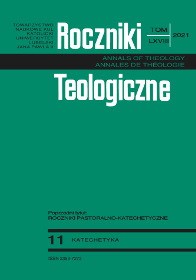Aktywizacja młodzieży szkół ponadpodstawowych w nauczaniu religii – między tradycją a współczesnością
Mobilisation of Secondary School Students in Religion Teaching – between Tradition and Modernity
Author(s): Anna ZellmaSubject(s): Christian Theology and Religion, Social Sciences, Education, Theology and Religion, School education, Pastoral Theology
Published by: Towarzystwo Naukowe KUL & Katolicki Uniwersytet Lubelski Jana Pawła II
Keywords: youth; religion teaching; secondary school; mobilizations; learning methods; activity; correlation
Summary/Abstract: The analyses presented in this study focus on the quality of secondary school student mobilisation, which is recommended in the valid Core curriculum of the Catholic Church catechesis in Poland (2018). Attention was drawn to the obligatory set of catechetic objectives – general requirements, the contents of religion teaching – specific requirements, attitudes that should be developed in young people, correlation of religion teaching with school education, recommended conditions and methods of implementation of syllabus and cooperation of the educational environment (family, parish, etc.). The analysis of these issues attempted to prove that all elements of essence and methodology in the religion core syllabus can play an important role in the mobilisation of young people. It was pointed out that transmission of the theological and catechetical message and the theological language dominates. These solutions are enriched by correlation with school education, which can contribute to the mobilisation of youth. Unfortunately, little attention is often devoted to human experience and students’ personal knowledge, which does not favour mobilisation. The new information and communication technologies are also undervalued, as they are mentioned in very general terms. Meanwhile, dominant are proposals of applying traditional methods of mobilising young people, such as problem methods, seeking and exploring. Proposals of forms and methods of young people’s evangelisation are lacking. Such an approach to youth mobilisation oscillates between tradition and modernity. There are more traditional accents. Hence, the analysed proposals for mobilising secondary school students require supplementing at the level of developing syllabuses and textbooks for religion teaching..
Journal: Roczniki Teologiczne
- Issue Year: 68/2021
- Issue No: 11
- Page Range: 57-69
- Page Count: 13
- Language: Polish

